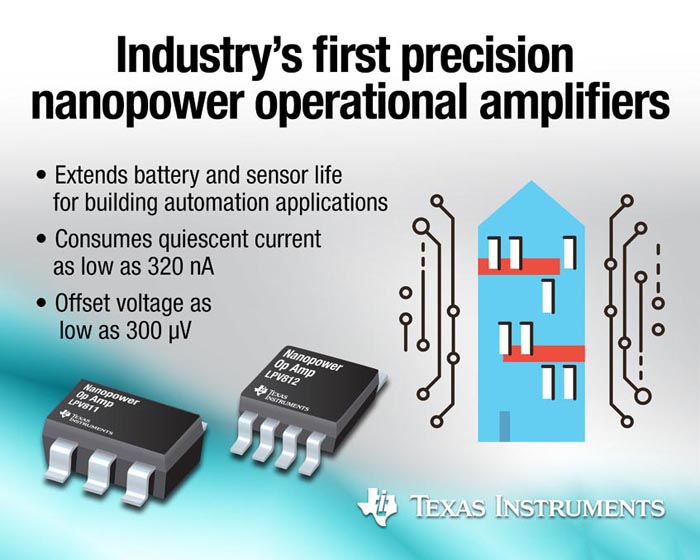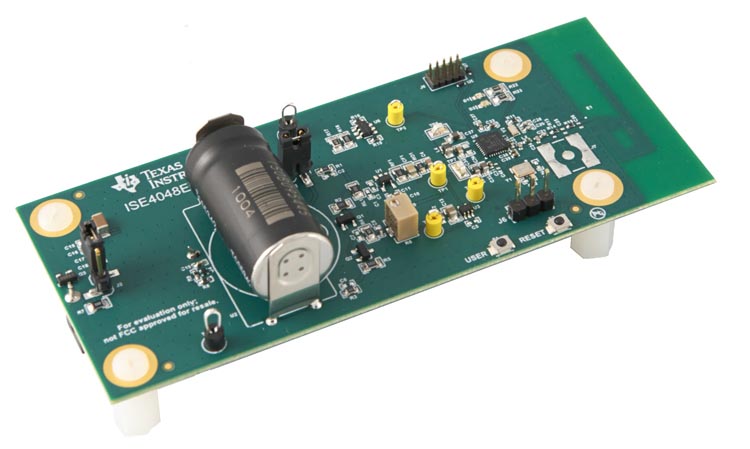New nanopower op amps maximize battery and sensor life
Texas Instruments (TI) introduced the industry's first precision nanopower operational amplifiers (op amps). The LPV811 and LPV812 consume quiescent current as low as 320 nA and are part of a family of four new ultra-low-power op amps. With up to 60 percent lower power consumption than competitive precision op amps and offset voltage as low as 300 µV, the new family of op amps extends battery and sensor life for applications such as building automation, wired and wireless sensor nodes, and wearables.

Key features and benefits of the LPV811 family
- Low power consumption:
Featuring industry-leading quiescent current without the use of duty cycling, these nanopower op amps enable more energy-efficient 4- to 20-mA loop systems, extend battery life and reduce battery replacement costs.
- High precision:
With a precision offset voltage as low as 300 µV and nanopower current consumption, the LPV811 and LPV812 help detect low concentrations of environmental gases and increase two-lead electrochemical sensor life and sensitivity.
- Low-voltage operation:
Operating with a single-supply voltage as low as 1.6 V, the general-purpose LPV801 and LPV802 and precision LPV811 and LPV812 maintain continuous performance under low-voltage battery conditions.
- High electromagnetic interference (EMI) immunity:
An input rejection ratio greater than 80 dB in the 500-MHz to 1-GHz frequency range reduces the need for external filtering components, saves design time for EMI-sensitive applications and enables rapid system qualification according to international standards organizations.
In addition, the LPV811 family of amplifiers can drive the ADS7042 successive approximation register (SAR) analog-to-digital converter, helping to deliver an ultra-low-power analog front end.
Tools and support to jump-start design
The Low Power Carbon Monoxide Sensor with 10+ Year Coin Cell Battery Life reference design demonstrates how the LPV811 nanopower op amp and the CC2650 SimpleLink™ multi-standard wireless microcontroller (MCU) reduce power consumption and extend the battery life of carbon monoxide gas detectors to as long as 10 years and extend their sensing range up to 1,000 parts per million. Designers also have access to a full suite of online support resources, including a complete library of TI Designs and SPICE models.
 |
| TIDA-00756 Low-Power Carbon Monoxide Detector With 10-Year Coin Cell Battery Life Reference Design. |
Package, availability and pricing
These new devices in TI's ultra-low-power op amp portfolio are available with package types and pricing listed in the table below.
| Product | Packaging | Pricing in 1,000-unit quantities |
Op amp type |
| LPV801 | 5SOT-23 | US$0.44 | Single channel, general-purpose |
| LPV802 | 8VSSOP | US$0.70 | Dual channel, general-purpose |
| LPV811 | 5SOT-23 | US$0.68 | Single channel, precision |
| LPV812 | 8VSSOP | US$0.95 | Dual channel, precision |
The LPV811 family is the latest addition to TI's growing portfolio of innovative ultra-low-power op amps that offers a leading combination of power, efficiency and accuracy.
